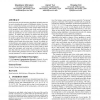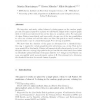47 search results - page 5 / 10 » The order of the largest complete minor in a random graph |
IMC
2010
ACM
13 years 5 months ago
2010
ACM
Social networks provide interesting algorithmic properties that can be used to bootstrap the security of distributed systems. For example, it is widely believed that social networ...
IM
2008
13 years 7 months ago
2008
In this paper we consider three models for random graphs that utilize the inner product as their fundamental object. We analyze the behavior of these models with respect to cluster...
EJC
2007
13 years 7 months ago
2007
We introduce and study online balanced coloring games on the random graph process. The game is played by a player we call Painter. Edges of the complete graph with n vertices are ...
TMC
2011
13 years 2 months ago
2011
—We propose a method to compute a probably approximately correct (PAC) normalized histogram of observations with a refresh rate of Âð1Þ time units per histogram sample on a ra...
SIGAL
1990
13 years 11 months ago
1990
We propose and analyse a quasirandom analogue to the classical push model for disseminating information in networks ("randomized rumor spreading"). In the classical mode...


